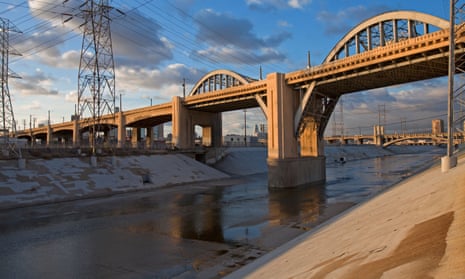Two highly toxic chemicals polluting a former Nasa research site are also probably contaminating the Los Angeles River and aquifer from which the region’s agricultural growers draw their water, watchdog groups and a whistleblower charge.
The Santa Susana field laboratory about 30 miles north of downtown Los Angeles is already notorious for its radioactive waste, but the site, which is owned by the federal government and Boeing, is also now suspected of leaching polychlorinated biphenyls (PCBs) and per- and polyfluoroalkyl substances (PFAS) “forever chemicals” into the water.
Despite evidence of the pollution and pressure from environmental groups to act, state regulators have so far allowed Boeing to continue polluting without a cleanup or proper monitoring for the dangerous chemicals, say the groups.
“California’s pollution control agencies are not just asleep at the switch but appear to be in a coma,” said Jeff Ruch, Pacific director of the non-profit Public Employees for Environmental Responsibility (Peer), which has filed a lawsuit over the site’s cleanup.
PFAS are a class of about 15,000 compounds most frequently used to make products water-, stain- and grease-resistant. The chemicals are linked to cancer, birth defects, decreased immunity, high cholesterol, kidney disease and a range of other serious health problems. They are dubbed “forever chemicals” because they do not naturally break down in the environment.
PFAS are the main ingredient in firefighting foam and are used in aerospace applications. Nasa and Boeing tested rockets at Santa Susana before the site’s 2006 closure, so the chemicals were probably employed in high quantities. PCBs are a chemical class that has been banned for over 40 years due to their high toxicity, but were used in industrial applications like electric transformers at Santa Susana.
The 2,800-acre site sits between the Simi and San Fernando valleys. Countless nuclear accidents occurred at the site, and residents living nearby have suspected radioactive waste from Santa Susana has sickened them.

The PFAS and PCB pollution in the ground probably migrates into the Los Angeles River headwaters. Water from the aquifer below the site is used by farmers in Ventura county and is likely to be contaminating crops, Peer charges.
Nasa in January 2021 alerted the California department of toxic substances control that “PFAS-containing materials are documented to have been located in the Nasa administered areas,” which the former recommended “for further investigation”.
But the investigation never happened, Ruch said. The Los Angeles regional water board, the state agency that could order monitoring and cleanup, meets on 28 September to consider a five-year pollution discharge permit for the site. A draft order posted on the agency’s website does not include requirements for PFAS and PCB monitoring or cleanup, but a spokesperson for the board told the Guardian the agency decided to add PFAS monitoring to the permit after public input.
No cleanup is currently planned, and Ruch said simply monitoring for PFAS is like “waving at the bank robbers as they leave the bank”.
“It’s a good first step, but would be much better if they stopped it from leaving the site,” he added.
Testing at the mouth of the Los Angeles River has found PCB levels 100 times higher than clean water limits, and in a spot where people frequently fish for sustenance, Ruch said.
after newsletter promotion
Regulators have said their testing found no PCBs at Santa Susana, but the state has conducted the wrong kind of test, a Los Angeles Regional Water Board whistleblower and Peer allege.
Evidence points to Santa Susana as the PCBs’ source, Ruch said, as all other potential PCB polluters along the river have been accounted for. The whistleblower has told Peer that intra-agency memos and communications show the agency is aware that PCBs are originating at Santa Susana, Ruch said.
Peer has tried to obtain those documents through a Freedom of Information Act request, but the agency has not turned them over, Ruch added. It is unclear if the new testing proposed by the water board will include the correct methodology, he said.
Governor Gavin Newsom’s administration and Boeing last year struck what Ruch characterized as a “sweetheart cleanup deal” that would only require the company to remove about 10% of the site’s contamination. It superseded a 2007 consent order with the state with more stringent monitoring requirements.
The deal, which Ruch said was struck behind closed doors and largely remains shielded from the public, also does not require testing for PFAS or PCBs. Peer and other environmental groups are suing the state to open the full deal to scrutiny, and to force a stricter cleanup.
Under the Newsom deal, the land would not be suitable for residential use after cleanup because it would remain so contaminated, the suit alleges.
“At the current rate of progress, Santa Susana is going to remain a toxic waste pit into perpetuity,” Ruch said.
